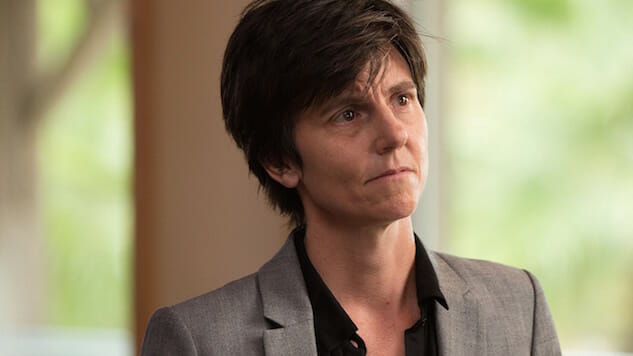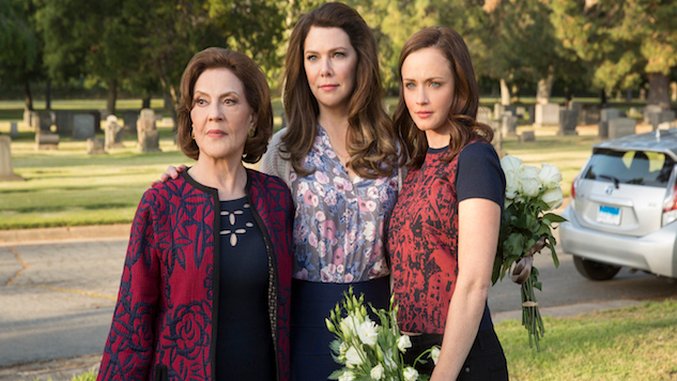The Year TV Gave Us Space to Grieve
Amazon Studios
In the pilot of Amazon Prime’s One Mississippi, Tig Notaro (playing a fictionalized version of herself) watches her mother die in the hospital following a freak accident. At the end of the episode, after the funeral, Tig finally listens to the last voicemail message her mom left her before she died. The scene is wordless: We don’t know what the message says, and Tig doesn’t offer any commentary—we simply sit with Tig in her quiet grief in a powerful moment of empathy.
Exploring death on television certainly isn’t new—death has always been a staple of storytelling. It’s a tool that can be used to heighten emotion, whether by placing beloved characters in peril or killing them for shock value. Sometimes it’s used simply to make annoying characters disappear. An episode or two will be devoted to the death and the aftermath: a funeral scene here, a graveyard scene there, with a couple of crying scenes in between. Beyond that, life more or less returns to normal. The introduction of new plot lines and characters keeps things fresh, and death is almost forgotten by season’s end.
When a TV series does put grief and its long-term effects front and center, it becomes not just a story of tragedy and death, but a potential source of healing for viewers who need it. We saw this with HBO’s Six Feet Under, which chronicled the lives of the Fisher family as they dealt with the death of patriarch Nathaniel during the very first episode. Seeing the characters face their grief with honesty throughout the series was powerful for many viewers.
This year has witnessed a resurgence of grief as one of the medium’s major themes: In addition to One Mississippi, which follows Tig as she returns to her hometown to deal with the repercussions of her mother’s death, Amazon is also the U.S. home to Fleabag, with Phoebe Waller-Bridge as the titular protagonist, reeling from not one but two deaths—her mother and her best friend—as she navigates the murky waters of adulthood.
And then there’s Netflix’s flawed Gilmore Girls revival, A Year in the Life, which nonetheless manages to treat Richard Gilmore’s death, and the beloved Gilmore women’s response to it, with lovely thoughtfulness. A number of nontraditional sitcoms have also dealt with grief in their most recent seasons, with You’re the Worst highlighting the complicated relationship Jimmy has with his deceased father, and Last Man on Earth exploring the profound loss each character has suffered in the apocalypse at the heart of the series’ premise.
What these series bring to their respective treatments of grief is an emotional depth and nuance that’s been missing on TV for quite some time. One Mississippi and Fleabag tackle grief head-on as dark comedies, achieving a delicate balance of pathos and humor by immersing themselves in the mundane absurdity of everyday life. We watch as Fleabag embarks on wacky misadventures, dates hilariously awful men, and has painfully awkward interactions with her family, for instance—but the deaths of her mother and friend inform her actions, her relationships, and her psyche in subtle ways that even she can’t untangle.

It’s this interweaving of multiple subjects and tonal registers that might be the most remarkable aspect of grief on TV in 2016 shows: Writers are now deftly threading grief throughout the lives of these characters, underscoring the typical foibles of romances, careers and families with a steady presence of loss. After all, grief isn’t relegated to the hospital bedside or the memorial service, as it’s often portrayed in media. Grief is what happens the day after. It’s what happens when the outpouring of condolence cards stop just as suddenly as they came. It’s brushing your teeth in the morning, and sitting at your desk at work, and cooking dinner at home. It’s what happens whenever a casual acquaintance asks Fleabag about her cafe, not knowing that they are inducing in Fleabag a world of memories, sadness, and guilt about her dead best friend. It’s what happens when Emily Gilmore finds herself bored and listless at DAR meetings she once loved to attend.
TV is especially rich with possibilities for examining grief, simply because the nature of its long-form structure allows writers, directors and performers enough time to sit with their character through its waves. We can see how grief sneaks up on a person unexpectedly, time and time again, long after the funeral ends. One of the most harmful misconceptions about grief is that it’s a linear process, a checklist of five steps to go through, and then you can officially “move on.” It creates the pressure to appear normal to others, when inside, as Fleabag says, you “just want to cry all the time.”
But crying isn’t all there is to grieving (and doesn’t have to be part of it at all). It’s a process that manifests itself in ways specific to each person. No one can ever quite know exactly how you’re feeling—even family members mourning the same loved one. One Mississippi considers this idea in its second episode, which finds Tig and her stepfather, Bill (John Rothman), arguing over what to do with the armchair in which Tig’s mother died. Tig wants to keep her mother’s favorite chair, while Bill can’t stand to look at it without his wife sitting there, and the anguish they both feel in their equally valid yet conflicting feelings is all too real for families bound together in tragedy.
In Fleabag and Gilmore Girls, we also see family members struggling with death in disparate and discordant ways, reflecting their temperaments and unique relationships to the deceased. These characters’ responses to grief run the gamut of emotions, in a sea of confusion and disfigurement that will continue in waves throughout their lives. As Notaro told Rolling Stone of her own experience with grief when One Mississippi premiered earlier this year, “Grief doesn’t work in a logical way. It’s never really over.”
